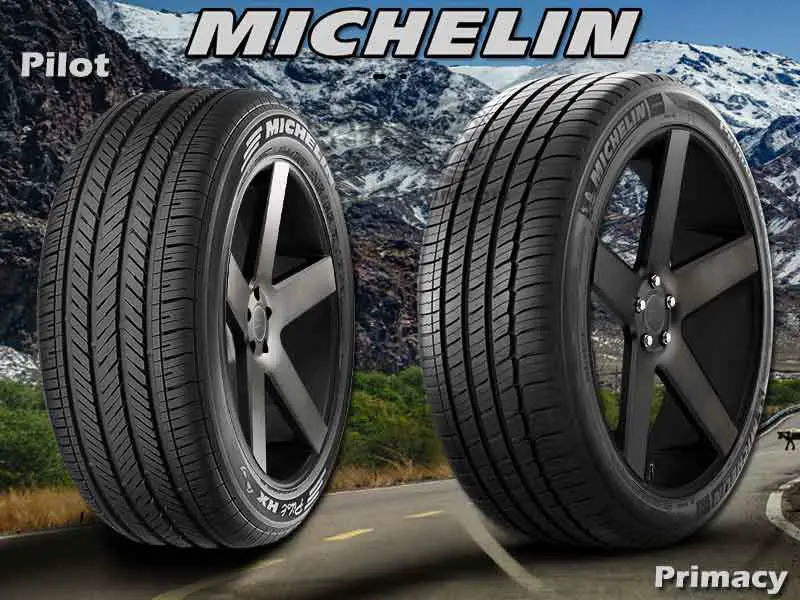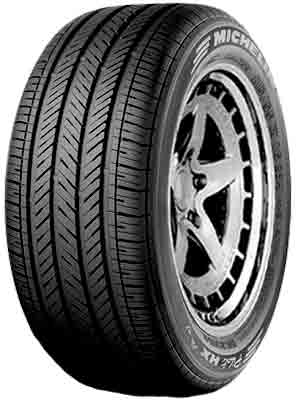Both contenders are manufactured by Michelin to provide an optimal touring experience under all-season conditions. It means that they can deliver refined ride quality with a higher speed rating than regular all-terrain tires throughout the year.
Pilot is a touring tire, with a symmetrical tread pattern, designed to provide excellent performance to passenger vehicles. Besides providing an enhanced grip on snowy roads, it also delivers the ultimate handling experience on wet and icy roads.

Primacy is an asymmetrical tire that provides premium on-road grip and precision handling. It delivers a quiet and comfortable ride for extended mileage. It is known for its high durability and supreme mileage warranty.
Compared to Pilot, Primacy has a better tread pattern, grip & handling on dry roads, and enhanced durability. But lacks behind when it comes to wet road handling, grip on snowy roads, and energy efficiency.
Table of Contents
Side By Side Comparison
Michelin Pilot MXM44

Michelin Primacy MXM44

Comparison Table
| Specifications | Michelin Pilot MXM4 | Michelin Primacy MXM4 |
| Tire Type | Touring Tire | Touring Tire |
| Tread Type | Symmetrical | Asymmetrical |
| Tire Season | All-season | All-season |
| Available Sizes, Inches | 16, 17, 18 | 17, 18, 19, 20 |
| Vehicle | Passenger car | Passenger car |
| Mileage Warranty | 50,000 miles | 55,000 miles |
| Standard Limited Warranty | 6 Years | 6 Years |
| UTQG Rating | 300AA | 500AAA |
| Tread Wear Indicator | Yes | Yes |
| Cost (245/45R17) | 269.18 $ | 262.31 $ |
Tread Design
Pilot has a symmetrical tread design which means that its inner and outer halves are identical. It consists of three ribs, two narrow circumferential grooves, and two wide & edged circumferential grooves adjacent to shoulder blocks. The central rib is embedded with two notches which makes its shape look like a series of the letter ‘S’. While the remaining ribs are divided by lateral grooves to make parallelogram-shaped tread blocks with a single notch on each block. Its shoulder blocks are comparatively smaller with relatively small lateral grooves. It has a moderate siping pattern on each tread block.
The tread design of Primacy is Asymmetric which indicates that its tread pattern is not uniform throughout the length. It is comprised of three central ribs, three straight circumferential grooves, and one zig-zag circumferential groove on its outer side. Its inner shoulder and two adjacent ribs have parallelogram-shaped tread blocks with lateral grooves and zig-zag sipes. On the other side (outer side), one shoulder and one rib have curved tread blocks of the same size, same-sized lateral groves but with a straight siping pattern. Its inner shoulder has a square-shaped dimple while its outer shoulder has two semi-circled-shaped dimples to provide aquaplaning during maneuvering. Generally, its lateral grooves are wider, circumferential grooves are smaller, and shoulder blocks are larger compared to its competitor.
Grip Comparison
On dry roads, Primacy would have a better grip since its contact patch is comparatively higher than its competitor. It’s because of having narrower circumferential grooves and relatively smaller notches which indicates a low void ratio in Primacy. Even though primacy takes the lead, Pilot would still have a decent on-road grip.
On wet roads, Primacy takes the lead once again because of having a larger contact patch and high-density siping. But Pilot would also be decent on wet roads due to having adequate siping density.
During snowy conditions, Pilot would perform comparatively better since its circumferential grooves are comparatively wider, especially the outer ones. They encapsulate the snow and throw it away from the vehicle. The grip of Primacy on snowy roads would not be adequate since its circumferential grooves are not wide enough to evacuate the snow.
On icy roads, Primacy would perform well since its contact patch is relatively higher and it also has high-density siping. Due to moderate sipe-density and contact patch, Pilot would perform moderately.
| Parameter | Pilot MXM4 | Primacy MXM4 |
| Dry Grip | Moderate | High |
| Wet Grip | Moderate | High |
| Snow Grip | High | Low |
| Ice Grip | Moderate | High |
Handling Comparison
Having comparatively larger shoulder blocks gives Primacy the advantage of being the better tire in handling operations on dry roads. On the other hand, Pilot would have lower handling on dry roads due to relatively lower shoulder blocks which means having a lower contact patch.
The siping density in Pilot’s shoulders is relatively higher than its competitor’s shoulders. This would improve its handling or steering operation on wet roads. But the hydroplaning resistivity of Primacy during maneuvering would also be decent and it can perform better wet handling.
With larger lateral grooves on its shoulders, Primacy would perform exceptionally well in snowy conditions. These larger shoulder grooves would provide maximum space for ice to get encapsulated and be thrown away from the vehicle during steering operation.
On icy roads, Pilot would have better handling efficiency due to high-density siping on its shoulder blocks. Primacy would perform moderately since it also has a decent siping density on its shoulder blocks.
| Parameter | Pilot MXM4 | Primacy MXM4 |
| Dry Handling | Low | High |
| Wet Handling | High | Moderate |
| Snow Handling | Low | High |
| Ice Handling | High | Moderate |
Comparison of Hydroplaning Resistivity
On wet roads, the best option would be Pilot. Even though its siping density lacks behind its competitor, its hydroplaning resistivity would be comparatively better due to the high void ratio and comparatively larger circumferential grooves.
Comfort & Noise
Having a high void ratio and more tread depth makes Pilot more uncomfortable and noisier compared to its competitor. It’s because wider grooves not only allow water or mud but also air which gets trapped and starts colliding with the tread walls, this is what causes noise and makes the journey uncomfortable.
So in this case, Primacy wins the race of being the quieter and more comfortable tire than its competitor.
Load & Speed
Load and speed rating of both ratings and values of identical size are being mentioned below.
| Contenders | Speed | Load (lbs.) | ||
| Rating | Value | Rating | Value | |
| Pilot (245/45R17) | H | 130 mph | 95 | 1521 |
| Primacy (245/45R17) | H | 130 mph | 99 | 1709 |
As we can see and conclude that the speed rating of both tires is equivalent but Primacy can withstand more load under the same conditions compared to its opponent.
Rolling Resistance and Fuel Efficiency
The resistance between the road and the tire, while it’s moving, is known as the rolling resistance. It can also be quantified as the energy consumed by the tires to overcome the resistance. The energy loss in this phenomenon is known as hysteresis. The hysteresis is directly related to the contact patch of the tire which means that the tire with a low void ratio would consume more energy to overcome the rolling resistance.
By that definition, it is clear that Primacy would have more energy consumption since it has a low void ratio and high contact patch. So Pilot is the winner in this race and a more energy-efficient tire.
Price
Pilot is slightly more expensive than its competitor which is unjustified since its competitor is better in many aspects such as on-road handling, mud-terrain traction, comfort, load endurance, and durability. The cost of a single unit of Michelin Pilot MXM4 (245/45R17) and Primacy MXM4 (245/45R17) is 269.18 $ and 262.31 $ respectively.
Quick Summary
Pilot has;
- Better grip on snowy roads.
- Better handling on wet and icy roads.
- 50,000 miles of mileage warranty.
- Enhanced energy efficiency.
- High-speed rating.
- Comparatively high cost.
Primacy has;
- Better grip on dry, wet, and icy roads.
- Better handling on dry and snowy roads.
- Optimal durability.
- High-speed rating.
- High load endurance.


